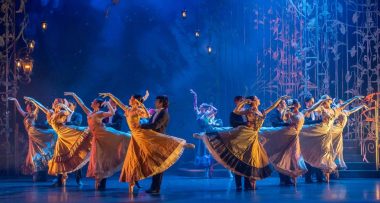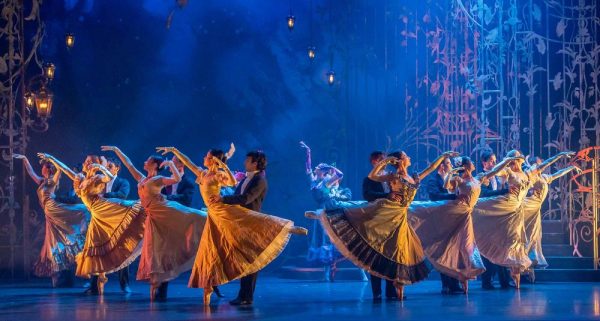 United Kingdom Cinders!: Dancers of Scottish Ballet, Scottish Ballet Orchestra / Wolfgang Heinz (conductor). Edinburgh Festival Theatre, 5.1.2024. (SRT)
United Kingdom Cinders!: Dancers of Scottish Ballet, Scottish Ballet Orchestra / Wolfgang Heinz (conductor). Edinburgh Festival Theatre, 5.1.2024. (SRT)

Creatives:
Music – Sergei Prokofiev
Choreography – Christopher Hampson CBE
Set and Design – Elin Steele
Lighting – Lawrie McLennan
Cast:
Cinders – Evan Loudon
Mother – Madeline Squire
Father – Benjamin Thomas
Mrs Thorne – Aisling Brangan
Morag – Grace Horler
Flossie – Kayla-Maree Tarantolo
Tarquin – Thomas Edwards
Princess Louise – Marge Hendrick
Duke of Orleans – Javier Andreu
Duke of Tonnerre – Aaron Venegas
Finding a fresh take on a tale as familiar as Cinderella is a tall order, so Christopher Hampson, Scottish Ballet’s Artistic Director, deserves a cheer for coming up with something fresh and interesting for the company’s restaging of his own 2015 production. It comes down to gender. In some performances, Cinders (note the gender-neutral name) is danced by a lady and recused by the handsome prince, while in other performances Cinders is a boy who is delivered from his grim life by the intervention of a princess. In a nice touch, the audience doesn’t know which version of the story they are going to get until the curtain goes up.
It is a lot more than a gimmick because it forces the dancers to rethink their role in the story. In almost every classical ballet, the assertive source of energy is the man, but when it is the woman everything has to be framed differently, and there is also the frisson of mystery for the audience as to which telling you are going to get.
The concept sits within Hampson’s bigger idea for the piece, which is set in a clothing emporium rather than in a fairytale kingdom. Cinders’ parents run the emporium but, when they die in a fire, the business is taken over by the nasty Mrs Thorne who brings in her three ghastly children. She allows Cinders to work there, but he/she is treated badly by the family. There isn’t much magic, but what there is comes from the spirits of Cinders’ parents rather than from a fairy godmother. Elin Steele’s pleasingly sturdy sets look terrific, as do the Victorian era costumes, and there is a beautiful breath-catching moment for the happily-ever-after final tableau.
This tour spent the month of December in Glasgow’s Theatre Royal; I saw it on its first night in Edinburgh, when Cinders was danced by … a man! Company Principal Evan Loudon danced the role with athleticism and vigour, though he cuts such a muscular presence on stage that you would never for a moment imagine him being oppressed or put down by Mrs Thorne’s family. When they torment him by ripping up the invitation to the ball, he could easily have lamped them and gone along anyway! Fellow Principal Marge Hendrick danced the princess, retaining the femininity of the part while bringing out the fact that she is ultimately in charge.

Hampson’s choreography is lovely to look at it, if a little limiting for Hendrick’s princess. There are a lot of leaps and pirouettes, and I often wished she had been given a bit more to do. She comes to life most in her gorgeous duets with Loudon’s Cinders, which slightly undermines the idea of challenging the piece’s power dynamic. The other parts are well taken, however. As the Thorne children, Grace Horler, Kayla-Maree Tarantolo and Thomas Edwards perform with a neat mix of slapstick and narrative energy, and I liked the pair of Dukes, who mirror one another well while providing more than just background presence. Some of the crowd scenes, particularly at the ball, seemed a little congested, which is odd when the corps de ballet is only sixteen people, though they may still be getting used to performing on the Edinburgh stage for their first night there.
Of course, the central problem in performing Cinderella is Prokofiev’s score. Even for a composer who wasn’t above reverting to autopilot, his score feels uninspired and insipid when you compare it to pretty much any other classical ballet, not least his own Romeo and Juliet. Scottish Ballet’s orchestra play it with as much panache as they can muster, and Wolfgang Heinz conducts it by making the rhythm the central element, but just how many lopsided waltzes are we expected to put up with in the course of an evening?!
The real appeal here is the visuals. Hampson’s production looks great and is commendably easy to follow. More importantly, the gender mystery element makes it fresh and surprising. How often can you go and see a classical ballet and genuinely not know what you are going to get?
Simon Thompson
At Edinburgh Festival Theatre until 20 January, then touring to Aberdeen, Inverness and Newcastle until 10 February. For information click here.
